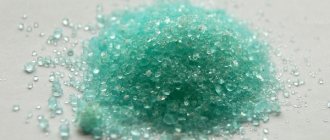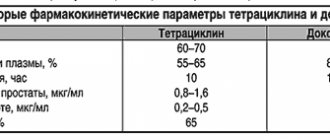Atropine (anatropine) - what is it? Atropine is an m-anticholinergic blocker (pharmacological group), a dangerous plant alkaloid and tropine ester. The medicine atropine looks like a white powder without a distinct odor, quickly dissolves in liquids, including alcohol and water. This substance is a poison for the human body; it is naturally found in nightshades: belladonna (belladonna), datura, henbane . Atropine sulfate formula: C17H23NO3.
Pharmacodynamics and pharmacokinetics
The main pharmacological property of atropine is that it is able to fully block M-cholinergic receptors. The substance can also have a somewhat weaker effect on H-cholinergic receptors. Therefore, it is considered a non-selective M-cholinergic receptor blocker.
After the introduction of atropine into the body, there is a decrease in the secretion of salivary, bronchial, gastric, sweat and pancreas, heart contractions become more frequent, and the tone of smooth muscle organs decreases. The effect of atropine is strongest when the tone of the vagus nerve is high, but in any case its mechanism of action is quite complex.
The use of atropine leads to a strong dilation of the pupils, depending on the degree of relaxation of the fibers of the orbicularis muscle in the area of the iris, innervated by parasympathetic fibers. Along with the dilation of the pupil, intraocular pressure may increase due to impaired outflow of fluid from the chamber. In this case, relaxation of the ciliary muscles of the ciliary body of the eye leads to paralysis of accommodation, which is a violation of visual perception.
Mechanism of action of atropine
The drug blocks M-receptors and nerve impulses. Atropine binds to areas of the brain instead of acetylcholine, as a result of which various abnormalities occur in the human body, including inhibition of impulses from the central nervous system and suppression of the secretion of sweat, salivary and a number of other glands. As a result, the smooth muscles of the intestines, gastrointestinal tract and bladder relax and expand. Atropine causes paralysis of accommodation and mydriasis, farsightedness, increased heart rate, bradycardia, and vasodilation.
Indications for use
The main indications for the use of Atropine sulfate are:
- peptic ulcer of the stomach and duodenum;
- pyloric spasms;
- cholelithiasis;
- bronchial asthma;
- the need to reduce the secretion of the salivary, gastric and bronchial glands;
- bradycardia;
- spasms of the intestines and urinary tract;
- pain caused by spasms of smooth muscles, as part of complex therapy.
Atropine can also be used in anesthesiological practice before anesthesia and surgery, which helps prevent the development of broncho- and laryngospasms , limit the secretion of the salivary and bronchial glands, reduce other reflex reactions and undesirable phenomena caused by excitation of the vagus nerve, and so on.
In ophthalmology, atropine is used when it is necessary to dilate the pupil to conduct a diagnostic examination of the eye, determine true refraction, and so on. In addition, the drug is used to treat:
- iritis – inflammation of the iris;
- iridocyclitis – simultaneous inflammation of the iris and cornea of the eyes;
- keratitis - inflammation of the cornea and some eye injuries.
Thanks to the relaxation of the eye muscles, functional rest is ensured and the elimination of a number of pathologies is accelerated.
Eye diseases for which Atropine is prescribed
Eye drops and solution for injection "Atropine" are used to treat the following ophthalmological pathologies:
- Iritis. Infectious inflammation of the iris. It manifests itself as lacrimation, decreased vision, redness of the eyeball, photophobia, eye pain and headache. They are characterized by a change in the color of the iris, its swelling, and constriction of the pupil.
- Choroiditis. Inflammation of the choroid of the eye. Caused by various infections (staphylococcus, streptococcus, brucellosis, toxoplasmosis, etc.). It is characterized by the formation of an inflammatory infiltrate and the formation of scar tissue. Not accompanied by visual disturbances or eye pain. There is hemorrhage in the choroid and vitreous body. When the peripheral parts are affected, it causes a decrease in twilight vision, and spots appear before the eyes. Pathology is diagnosed using ophthalmoscopy.
- Myopia, or nearsightedness. Characterized by visual impairment, when distant objects are poorly distinguished, but at the same time the person sees well near. Myopia is accompanied by visual fatigue, progressive deterioration of visual acuity, and headache.
- Keratitis is inflammation of the cornea of the eye. It manifests itself as redness and pain in the eyes, clouding of the cornea, and decreased vision. Frequent symptoms: lacrimation, cutting pain in the eyes, sensation of a foreign body in the eye, photophobia. The nature of occurrence is infectious.
- Iridocyclitis, or uveitis, is an inflammation of the iris and ciliary body. Characteristic manifestations: blurred vision, redness, constriction of the pupil, photophobia, blurred vision. It develops as a result of the penetration of viruses and infections, and can also be a complication of common diseases.
- Embolism of the central retinal artery. It occurs in older people and is characterized by a sharp and sudden loss of vision in one eye. The disease is based on acute blockade of the central ophthalmic artery and subsequent retinal ischemia.
Instructions for Atropine sulfate (Method and dosage)
According to the instructions for use of Atropine sulfate, the drug can be used in different ways: taken orally, parenterally and locally. Quite often it is administered by injection: by injection into a vein, muscle or under the skin. In this case, the dosage of the drug is established by the attending physician, taking into account the type, complexity of the disease and the characteristics of the patient’s body.
In ophthalmic practice, eye drops with a concentration of 0.5-0.1% of the active substance are used. The therapeutic dosage is 1-2 drops instilled 2-6 times a day. Particularly severe cases are supplemented by applying 1% atropine ointment to the eyelids in the evenings.
Treatment of intoxication
How to cope with poisoning? How is acute atropine intoxication treated? First of all, you need to call the Favorit RC and call the emergency drug treatment service to your home. Doctors will arrive within 30-40 years. However, quite often victims require pre-medical assistance; you can get detailed advice from professionals by calling our clinic’s hotline absolutely free. The patient will also need emergency medical care and then hospital treatment.
How to remove poison from the body without harming the health of the addicted person? First of all, doctors carry out a detoxification procedure. To cleanse the body of toxins as quickly as possible, droppers with adsorbents and a number of medications are used to speed up metabolism and normalize the patient’s general condition. In addition, depending on the degree of intoxication, the following measures are used: gastric lavage (potassium permanganate), induction of vomiting, use of laxatives and diuretics, hemosorption.
Next comes the turn of symptomatic treatment and elimination of physiological disorders in the addict’s health. The drugs are used according to indications and contraindications. In case of severe clinical picture and breathing problems, tracheal intubation and artificial ventilation are used, resuscitation measures include installation of a catheter and administration of the necessary medications intravenously.
In case of atropine poisoning, the victim must be given an antidote: Physiostigmine, Aminostigmine, Nivalin or Galantamine in an individual dosage. These drugs help to quickly get rid of the unpleasant consequences of intoxication and symptoms such as hallucinations.
Overdose
In case of an overdose, severe dryness in the mouth, burning sensation, difficulty swallowing, severe photophobia, redness and peeling of the skin, fever, rash, nausea, vomiting, tachycardia and arterial hypertension may occur.
The drug may have effects on the nervous system, often causing anxiety, tremors , confusion, agitation, hallucinations and delirium, as well as excessive drowsiness and stupor. Such conditions often result in death, which can lead to cardiovascular or respiratory failure.
In particularly severe cases, the administration of Physostigmine , and Diazepam . All this time it is necessary to constantly monitor the airway. Inhalation with oxygen or carbon dioxide will help prevent the development of respiratory failure.
of fever appear , it is better to use cold compresses or wiping with water, and organize adequate fluid intake. If necessary, urethral catheterization is performed.
Narcotic effect of atropine
The body's response varies greatly depending on the dose consumed. When using a small dose of the substance, a surge of strength and energy occurs, and mood improves. Taking an average dose leads to stress relief and relaxation; an overdose of the drug is fraught not only with poisoning and hallucinations, but also with death. The narcotic effect of atropine is explained by the accumulation of acetylcholine in the synoptic cleft, inhibition of parasympathetic effects and the functioning of the nervous system.
If the permissible daily dosage is exceeded, a person feels warm and relaxed, relaxed, euphoric and slightly dizzy. The narcotic effect of atropine can be compared to the use of marijuana and other cannabinoids containing THC. How a drug affects a person depends on his mood and state of mind before use. If the mood is negative, the substance will only intensify the reaction, which can lead to panic attacks and depression.
Euphoria after a few hours is replaced by the opposite effect: drowsiness, lethargy, weakness, emptiness, weakness. A person has problems with the gastrointestinal tract and a headache. The higher the dose of atropine, the stronger the symptoms of intoxication, the person begins to behave inappropriately, and psychosis occurs due to the effect of the drug on the central nervous system. They are accompanied by mydriasis, insomnia, tachycardia, pressure surges, and behavioral and mental abnormalities. This condition can last about 24 hours.
Interaction
The use of this drug helps to weaken the effect of m-cholinomimetics and anticholinesterase drugs. Significantly enhance the effectiveness of Atropine sulfate by drugs with anticholinergic activity, Diphenhydramine and Promethazine.
Simultaneous use with antacids that contain Al3+ or Ca2+ leads to a decrease in the absorption of the active component from the gastrointestinal tract. Combination with tricyclic antidepressants, Amantadine, Phenothiazine, Quinidine , antihistamines and other drugs with m-anticholinergic properties often enhances the manifestation of systemic undesirable effects. Some nitrates cause an increase in intraocular pressure, while atropine sometimes alters the absorption of Levodopa and Mexiletine.
Features of use during pregnancy and lactation
It is known that the active substance of the drug can cross the placental barrier. The components of the drug are also found in breast milk in small concentrations. The effect of the drug on pregnancy has not been studied, so its use during this period is allowed only if the expected benefit to the mother significantly outweighs the potential risk to the child.
It is not prescribed to women whose pregnancy is complicated by gestosis, since in this case the risk of arterial hypertension increases. During lactation, if treatment is necessary, breastfeeding should be stopped.
special instructions
When using Atropine sulfate, you must strictly monitor the presence of conditions in which the drug is prescribed with extreme caution, for example, disorders of the cardiovascular system:
- tachycardia;
- atrial fibrillation;
- coronary heart disease;
- chronic heart failure;
- arterial hypertension;
- mitral stenosis and other diseases.
It is necessary to maintain an interval of at least an hour between the use of Atropine and antacid drugs. To reduce tachycardia, the patient should be given a Validol . During treatment, it is also necessary to exercise caution when engaging in hazardous activities and driving a car.
Treatment of atropine addiction in Rostov-on-Don
Treatment of atropine addiction, as well as addiction to any pharmaceutical drugs, takes place in a drug rehabilitation center in Rostov-on-Don. Therapy includes detoxification and symptomatic treatment, as well as rehabilitation, which stabilizes the addict’s condition and consolidates the treatment results. Doctors help patients eliminate psychological cravings for psychoactive substances through group and individual sessions. During the treatment process, various psychotherapeutic and medicinal techniques are used, as well as psychocorrection and family therapy, especially necessary for adolescents. The last step in the treatment of drug addiction is resocialization and adaptation to society.
Analogues of Atropine sulfate
Level 4 ATC code matches:
Belladonna extract
Becarbon
As the Pharmacopoeia indicates, analogues of this drug are: Appamide Plus, Bellacechol, Cyclomed, Hyoscyamine, Midriacil, Midrimax, Bekarbon and Cycloptic.
Note!
The description of the drug Atropine on this page is a simplified author’s version of the apteka911 website, created on the basis of the instructions for use.
Before purchasing or using the drug, you should consult your doctor and read the manufacturer's original instructions (attached to each package of the drug). Information about the drug is provided for informational purposes only and should not be used as a guide to self-medication. Only a doctor can decide to prescribe the drug, as well as determine the dose and methods of its use.
Reviews of Atropine sulfate
As you know, this drug is one of the most popular, which is why reviews of Atropine sulfate are found on the Internet quite often. Although discussions of its effectiveness rarely involve those who have ever been prescribed it.
Usually, opinions about it are left by relatives of patients who have ever taken this drug or people who have just been prescribed Atropine sulfate for use.
Quite often, users note how important it is to follow the dosage of this drug. The fact is that an overdose can lead to severe poisoning, the symptoms of which can manifest themselves in all their diversity. There are also a number of recommendations when this drug should be used with extreme caution - this also needs to be remembered.
According to medical experts, Atropine sulfate is a specific and potent drug. To buy it at a pharmacy, a prescription is written in Latin. It can only be taken strictly as prescribed by a doctor, strictly observing the dosage and established therapeutic regimen.
The emergence of addiction and its treatment
In pursuit of new unusual sensations and euphoria, as well as an attempt to get away from problems, people turn their attention to pharmaceutical drugs. This is exactly the effect that atropine gives: fogginess of consciousness, withdrawal from reality, artificial elevation of mood. Not all people know about the dangers of atropine and the consequences of its regular and excessive use. Even a person who has been prescribed a drug by doctors can become addicted to the drug. Having felt the effect of the drug, a person may become psychologically dependent on its effect.
If a drug helps an addict cope with depression, stress, internal problems and complexes, he will use it again and again, which will lead to addiction. However, no chemical substance can be used for a long time without consequences for the body. The longer the period of use, the more the addict degrades both physically and mentally. As a result of acquiring drug addiction, people only have more problems, they grow like a snowball and do not allow a person to get out of the vicious circle. Only doctors at the Favorit drug treatment clinic in Rostov-on-Don can save a person from imminent death.
The development of addiction is also influenced by the fact that a person stops receiving pleasure in the usual way: from delicious food, walks with friends, a favorite activity, communication with loved ones. The only source of pleasure, euphoria and pleasure is atropine. Soon the addict begins to realize that the usual dose no longer gives the desired effect, so he gradually increases the dosage and also begins to use other pharmaceutical drugs or psychotropic substances. step by step a person loses himself as an individual and becomes one step closer to death.
Atropine sulfate price, where to buy
You can buy Atropine sulfate in the form of a solution for a price starting from 8 rubles.
The cost of eye drops is from 40 rubles.
- Online pharmacies in RussiaRussia
- Online pharmacies in UkraineUkraine
- Online pharmacies in KazakhstanKazakhstan
Pharmacy Dialogue
- Atropine sulfate (amp. 0.1% 1 ml No. 10) DHF OJSC
47 rub. order
show more
PaniPharmacy
- Atropine liquid Atropine sulfate h/c 1% 5ml Ukraine, OZ GNTsLS LLC
39 UAH.order - Atropine ampoule Atropine sulfate solution d/in. 0.1% amp. 1ml No. 10 Ukraine, Darnitsa ChAO
31 UAH order
- Atropine ampoule Atropine sulfate solution d/in. 0.1% amp. 1ml No. 10 Ukraine, OZ GNTsLS LLC
20 UAH order
show more


